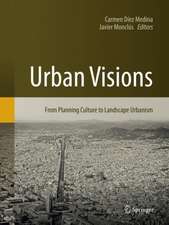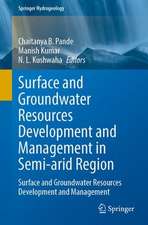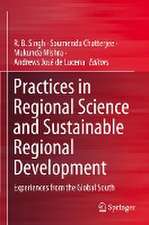Geoecology of Landscape Dynamics: Advances in Geographical and Environmental Sciences
Editat de Seema Sahdev, R. B. Singh, Manish Kumaren Limba Engleză Hardback – 4 mar 2020
In turn, the relevant aspects of land use and land cover dynamics are covered, and the multi-faceted relationship between the substrata and ecological community is highlighted. The book is unique in its focus on the application of spatial informatics such as automatic building extraction from high-resolution imagery; a soil resource inventory for meeting the challenges of land degradation; hydrological modeling; the temporal variation analysis of glacier area and the identification and mapping of glacial lakes; morphometric analysis of river basins; and the monitoring and modeling of urban sprawl, among other features.
| Toate formatele și edițiile | Preț | Express |
|---|---|---|
| Paperback (1) | 640.53 lei 6-8 săpt. | |
| Springer Nature Singapore – 4 mar 2021 | 640.53 lei 6-8 săpt. | |
| Hardback (1) | 576.85 lei 38-44 zile | |
| Springer Nature Singapore – 4 mar 2020 | 576.85 lei 38-44 zile |
Din seria Advances in Geographical and Environmental Sciences
- 18%
 Preț: 961.19 lei
Preț: 961.19 lei - 18%
 Preț: 938.03 lei
Preț: 938.03 lei - 18%
 Preț: 1211.42 lei
Preț: 1211.42 lei - 18%
 Preț: 1013.08 lei
Preț: 1013.08 lei - 15%
 Preț: 635.34 lei
Preț: 635.34 lei - 18%
 Preț: 1109.57 lei
Preț: 1109.57 lei - 18%
 Preț: 1014.01 lei
Preț: 1014.01 lei - 18%
 Preț: 1005.39 lei
Preț: 1005.39 lei - 17%
 Preț: 524.29 lei
Preț: 524.29 lei - 18%
 Preț: 725.72 lei
Preț: 725.72 lei - 18%
 Preț: 941.93 lei
Preț: 941.93 lei - 18%
 Preț: 1003.82 lei
Preț: 1003.82 lei - 18%
 Preț: 948.97 lei
Preț: 948.97 lei - 18%
 Preț: 938.82 lei
Preț: 938.82 lei - 18%
 Preț: 943.51 lei
Preț: 943.51 lei - 18%
 Preț: 952.92 lei
Preț: 952.92 lei - 18%
 Preț: 729.65 lei
Preț: 729.65 lei - 18%
 Preț: 727.62 lei
Preț: 727.62 lei - 18%
 Preț: 885.38 lei
Preț: 885.38 lei - 24%
 Preț: 641.28 lei
Preț: 641.28 lei - 18%
 Preț: 887.88 lei
Preț: 887.88 lei - 18%
 Preț: 1105.66 lei
Preț: 1105.66 lei - 18%
 Preț: 1093.88 lei
Preț: 1093.88 lei - 18%
 Preț: 952.92 lei
Preț: 952.92 lei - 18%
 Preț: 963.86 lei
Preț: 963.86 lei - 18%
 Preț: 784.47 lei
Preț: 784.47 lei - 15%
 Preț: 689.76 lei
Preț: 689.76 lei - 18%
 Preț: 887.11 lei
Preț: 887.11 lei - 18%
 Preț: 954.45 lei
Preț: 954.45 lei - 18%
 Preț: 887.11 lei
Preț: 887.11 lei - 18%
 Preț: 1113.47 lei
Preț: 1113.47 lei - 18%
 Preț: 947.42 lei
Preț: 947.42 lei - 18%
 Preț: 949.77 lei
Preț: 949.77 lei - 18%
 Preț: 775.07 lei
Preț: 775.07 lei - 18%
 Preț: 786.06 lei
Preț: 786.06 lei - 18%
 Preț: 887.88 lei
Preț: 887.88 lei - 18%
 Preț: 941.93 lei
Preț: 941.93 lei - 18%
 Preț: 786.06 lei
Preț: 786.06 lei - 15%
 Preț: 637.78 lei
Preț: 637.78 lei - 18%
 Preț: 1009.93 lei
Preț: 1009.93 lei - 18%
 Preț: 774.64 lei
Preț: 774.64 lei -
 Preț: 401.50 lei
Preț: 401.50 lei - 15%
 Preț: 642.51 lei
Preț: 642.51 lei - 24%
 Preț: 821.40 lei
Preț: 821.40 lei - 18%
 Preț: 1223.30 lei
Preț: 1223.30 lei - 24%
 Preț: 683.50 lei
Preț: 683.50 lei
Preț: 576.85 lei
Preț vechi: 721.07 lei
-20% Nou
Puncte Express: 865
Preț estimativ în valută:
110.48€ • 113.82$ • 92.55£
110.48€ • 113.82$ • 92.55£
Carte tipărită la comandă
Livrare economică 20-26 februarie
Preluare comenzi: 021 569.72.76
Specificații
ISBN-13: 9789811520969
ISBN-10: 9811520968
Pagini: 381
Ilustrații: IX, 381 p. 150 illus., 132 illus. in color.
Dimensiuni: 155 x 235 mm
Greutate: 0.68 kg
Ediția:1st ed. 2020
Editura: Springer Nature Singapore
Colecția Springer
Seria Advances in Geographical and Environmental Sciences
Locul publicării:Singapore, Singapore
ISBN-10: 9811520968
Pagini: 381
Ilustrații: IX, 381 p. 150 illus., 132 illus. in color.
Dimensiuni: 155 x 235 mm
Greutate: 0.68 kg
Ediția:1st ed. 2020
Editura: Springer Nature Singapore
Colecția Springer
Seria Advances in Geographical and Environmental Sciences
Locul publicării:Singapore, Singapore
Cuprins
Land use land cover dynamics using Remote Sensing and GIS techniques in Western Doon Valley, Uttarakhand, India.- Spatial analysis and mapping of malaria risk in Dehradun city India: A geospatial technology based decision making for planning of control.- Sustainable Energy Development and Participatory Management Scenario in Sundarbans: A Case Study from Sagar Island, West Bengal, India.- Robust and reliable technique of automatic building extraction from high resolution imagery.- Soil Resource Inventory for Meeting Challenges of Land Degradation: A Remote Sensing Approach.- Controlling Challenges of Urban Surface Run-Off Water: A Sustainable Approach.- Hydrological Modeling Using SWAT Model and Geoinformatic Techniques.- Green Buildings: Building a Greener City, a Greener Future An Indian Perspective.- Human Capital Impact for Sustainable Economic Growth.- Temporal variation in glacier’s area and Identification of glacial lakes in Sikkim.- UN SDGs and context of Heritage cities in India: a study of Ayodhya and Varanasi.- Morphometric Analysis of the Yerla Watershed of the Krishna River Basin using Spatial Information Technology.- Conceptualising and Measuring Social Capital as a Sustainable Development Strategy in Mewat Region, Haryana.- Analysing the capability of NCI technique in change detection using high and medium resolution multispectral data.- Monitoring and Modelling of Urban Sprawl Using Geospatial Techniques: A Case Study of Shimla City, India.- Comparison of Multi Temporal Drought Indices Using Monthly Precipitation in the Western Part of the West Bengal.- Dying and Dwindling of Non-Glacial Fed Rivers Under Climate Change: A Case Study from The Upper Kosi Watershed, Central Himalaya, India).- Planning of Integrated Land use & Social Infrastructure of SAS Nagar (Mohali).- Agroforestry Ecosystem in Himalayan Region of Uttarakhand Using Remote Sensing and Geographic Information System.- A study of Development along Delhi-Jaipur Express using Geospatial Technology.- Slope Vulnerability, Mass Wasting and Geohydrological-hazards in Himalaya: A Case Study of Alaknanda Basin, Uttarakhand, India.- Demarcation of Hyper Arid Land in the Indian Desert: An Environmental Analysis.
Notă biografică
Dr. Seema Sahdev is an associate professor in the Department of Geography at Kalindi College, University of Delhi. Dr. Sahdev completed her M.Phil. at the University of Delhi and her Ph.D. at Jamia Millia Islamia University, New Delhi. She had worked in several administrative posts of the College and organized awareness programmes related to disaster management for students and faculty members as well. She convened the International Conference on the Spatial Decision Support System for United Nations Sustainable Development Goals and the National Seminar on Environmental Ethics, Resource Depletion, and Sustainable Development. Dr. Sahdev has published a book as well as research papers in national and international journals including National Geographical Journal of India, Goa Geographers, and International Journal of Computer Science. She edited the book Environment and Sustainable Development: A Geographical Appraisal (Concept Publishing, 2018). Her research domain includes political geography, electoral geography, environmental geography, and disaster management
Dr. R.B. Singh is a professor of geography at the Delhi School of Economics, University of Delhi; the secretary general and treasurer of the International Geographical Union (IGU); the chair of Council for Scientific and Industrial Research (CSIR)–Central Food Technological Research Institute of the Government of India, and a member of the International Council for Science (ICSU) and the scientific committee Urban Health and Well-Being. He was awarded the prestigious Japan Society for the Promotion of Scientific Research Fellowship and has presented papers and chaired sessions in more than 40 countries. He has published 14 books, 35 edited research volumes, and more than 215 research papers. He has supervised 34 Ph.D. and 79 M.Phil. students. In 1988 the Unesco/the International Social Science Council awarded him research and study grants in social and human sciences.
Dr. Manish Kumar is an assistant professor in the Department of Geography at Kalindi College, University of Delhi. From January 2009 to December 2014, Dr. Kumar has also worked as lecturer in M.Sc. remote sensing and GIS course of Kumaun University, Nainital. Dr. Kumar has worked as a research associate in the UNDP project on “rurbanization,” making small town hubs of rural productivity, in a Delhi policy group. He is also a visiting faculty at SPA, Delhi. Dr. Kumar holds a Ph.D. from Kumaun University as well as a postgraduate diploma in remote sensing and GIS from the IIRS, Dehradun. He has published more than 25 research papers in various national and international Scopus-indexed journals. His special area of research interest includes the application of remote sensing and GIS in urban and regional planning, land use and land cover dynamics, climate change etc.
Textul de pe ultima copertă
This book provides an overview of the ecological indicators of landscape dynamics in the context of geographical landscape integration. Landscape dynamics depicts every change that occurs in the physical, biological, and cognitive assets of a landscape. To understand and interpret the complex physical, biological, and cognitive phenomena of landscapes, it is necessary to operate conceptually and practically on a broad range of spatial and temporal scales. Rapid land use changes have become a concern to environmentalists and planners because of their impacts on the natural ecosystem, which further determines socioeconomic dynamics. In this regard, the book discusses case studies that share new insights into how landscape patterns and processes impact small creatures, and how small creatures in turn influence landscape structure and composition.
In turn, the relevant aspects of land use and land cover dynamics are covered, and the multi-faceted relationship between the substrata and ecological community is highlighted. The book is unique in its focus on the application of spatial informatics such as automatic building extraction from high-resolution imagery; a soil resource inventory for meeting the challenges of land degradation; hydrological modeling; the temporal variation analysis of glacier area and the identification and mapping of glacial lakes; morphometric analysis of river basins; and the monitoring and modeling of urban sprawl, among other features.
Caracteristici
Reveals the human dimensions of sustainability through its cultural ecological approach Contributes a spatio-temporal perspective for integrated assessment through landscape dynamics Covers spatial informatics techniques to contribute to the Landscape Decision Support System (LDSS)

















